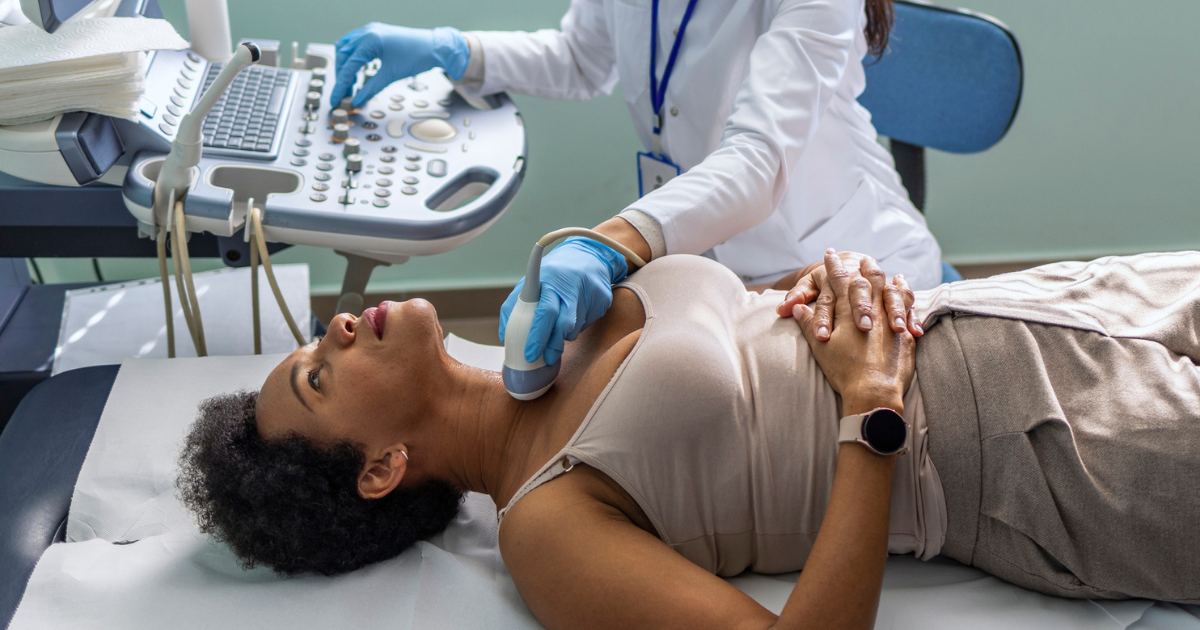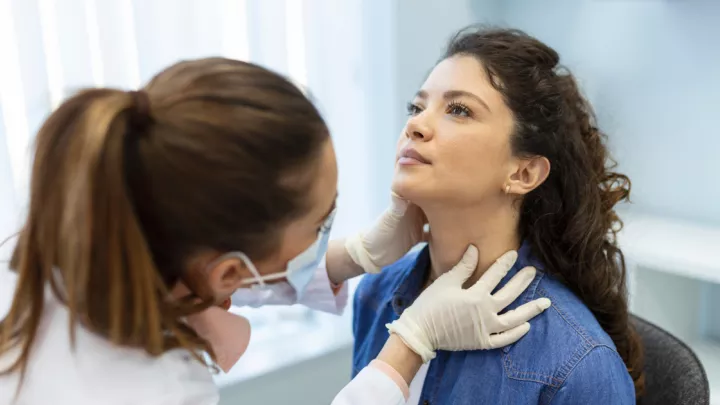What are thyroid nodules, and how are they removed?

The thyroid is a small, butterfly-shaped gland located in the midline of the neck. This gland produces the thyroid hormone, which controls most of our metabolism and how heat and cold affect us. Essentially, the thyroid controls multiple mechanisms and bodily functions. “Consequently, too much or too little thyroid hormone can affect these vital functions, including nerve and brain function and general well-being,” says endocrinologist Anupam Kotwal, MBBS.
What are thyroid nodules?
Unfortunately, the thyroid gland can develop lumps. These lumps, which can be single, multiple or even cover the entire thyroid, are called nodules.
Still, it’s necessary to monitor any nodules you notice and have them examined by a health care professional. Still, it’s vital to understand that most thyroid nodules are NOT cancerous. “Approximately 90% of thyroid nodules are benign,” says Dr. Kotwal, “and anywhere from 10% to 15% are cancerous.”
Why do thyroid nodules form?
Scientists and health care providers still don’t completely understand how and why thyroid nodules form; however, several known factors boost an individual’s likelihood of having one. “We know that an iodine deficiency increases chances of thyroid enlargement and nodules,” says Dr. Kotwal. “Fortunately, in most countries, especially North America, food contains enough iodine, so this issue is largely null.”
There’s also an increased risk of thyroid nodules with radiation exposure, especially during childhood. Usually, this radiation exposure is from radiation given as a treatment. Still, it can also include radiation exposure from multiple imaging or an environmental catastrophe.
“Autoimmunity, what we call Hashimoto’s disease, or autoimmune thyroid disease, can also increase the risk of nodules,” says Dr. Kotwal. “Additionally, we know people with multiple family members with thyroid nodules are more likely to develop a nodule themselves.”
Similarly, studies show that the frequency of thyroid nodules increases with age. Approximately 6% of North Americans have thyroid nodules, but about 50% of people age 60 or older have one. “Conversely, as a person ages, the likelihood of a thyroid nodule being cancerous decreases,” says Dr. Kotwal. “Studies have found that for people in their 20s, approximately 15% of nodules were cancerous, while only 5% of people in their 70s had a nodule that is cancerous.”
Finally, those assigned female at birth are six to eight times more likely to develop thyroid nodules than those assigned male at birth. Each of these characteristics can increase your risk of developing thyroid nodules. However, there’s no guarantee you’ll have a thyroid nodule, regardless of your risk factors.
How do providers find a thyroid nodule?
Typically, a patient notices a thyroid nodule themselves or a provider examining the neck feels an enlargement. A person may also notice difficulty in swallowing foods or liquids, changes in the quality of their voice, or a choking-like sensation in the neck. Any of these concerns should prompt some imaging, usually an ultrasound or a sonogram of the thyroid gland.
“Another way we’re finding these nodules is by imaging for other reasons,” says Dr. Kotwal. “For example, if someone was in a motor vehicle accident and got a CT scan or they’re undergoing screening for lung cancer with a CT of the lungs, which includes pictures of the lower part of the neck.”
Essentially, providers may find these nodules incidentally. In such instances, the patient generally doesn’t feel any discomfort, and the nodules are non-symptomatic. “The more concerning nodules are ones the patient actually feels,” says Dr. Kotwal, “because this discomfort means the nodule is getting bigger. Regardless of size, discovery leads to further imaging, typically an ultrasound, to confirm the nodule, its size and its appearance. Each of these factors gives us an idea of its suspicion for cancer.”
During this imaging, your provider will also examine the lymph nodes next to the thyroid gland because if a nodule is cancerous, it can spread to nearby lymph nodes. Your provider will also test your blood for hormone levels to determine if your thyroid produces too much or too little thyroid hormone.
“In cases where a thyroid nodule is larger than one centimeter and has characteristics from the ultrasound that show a moderate to high concern for cancer, we would biopsy the nodule next,” says Dr. Kotwal. “Otherwise, we can continue monitoring the nodules with more ultrasounds.”
Not every thyroid nodule requires a biopsy. “Most thyroid nodules are small and don’t look suspicious on an ultrasound,” says Dr. Kotwal. “So, they may not need biopsies but do require some monitoring for change in their size or appearance, which could then prompt a biopsy.”
What happens if a thyroid nodule is cancerous?
When a thyroid nodule comes back positive for cancer, your provider will typically want to double-check the area around the thyroid – like nearby lymph nodes – to ensure the cancer hasn’t spread anywhere else. “We want to confirm the nodule is the only concerning area, and if there is a concerning lymph node, we’ll want to biopsy it, too,” says Dr. Kotwal.
Usually, the following step is surgery. “Of the 10% to 15% of nodules that are cancerous, approximately 90% of them are what’s called differentiated thyroid cancer,” says Dr. Kotwal. “This type of thyroid cancer occurs when cells have become cancerous but still behave somewhat similarly to a normal thyroid.”
Those with differentiated thyroid cancer will generally have surgery to remove the entire thyroid or the half of the thyroid with the nodule. For rare types of thyroid cancers, you may require more extensive surgery or, in some cases, some treatment before surgery to compress the nodule.
“Then, after surgery, depending on the extent of the cancer – and how many lymph nodes are involved or if it’s spreading outside of the neck and thyroid – we give patients another treatment, called radioiodine or radioactive iodine,” says Dr. Kotwal. “This targeted treatment helps destroy small amounts of cancer that could remain in a patient after a thyroidectomy.”
Note that radioactive iodine treatment isn’t for all patients. Providers reserve it for cancers that are at a higher risk level or have some involvement outside of the thyroid gland.
Removing a thyroid nodule
Until recently, a complete removal of the thyroid gland, called a total thyroidectomy, was the typical next treatment step after discovering a cancerous thyroid nodule, regardless of its size. “Recently, though, this has begun to change, as more providers have found that if a patient’s thyroid cancer was smaller than two to three centimeters and limited to the thyroid, they did well if providers only removed the half of their thyroid that had cancer,” says Dr. Kotwal.
This partial removal – called a hemithyroidectomy – can be beneficial as it presents fewer potential complications than a total thyroidectomy. “In addition to making the patient hormone-dependent, a total thyroidectomy has a slightly higher risk of nerve issues, voice problems or parathyroid issues, which can cause problems with your calcium,” says Dr. Kotwal.
Still, deciding between a total- and hemi-thyroidectomy is ultimately the patient’s choice. Despite having fewer potential complications, a hemithyroidectomy may require further surgery in the future and demands subsequent monitoring to ensure the cancer doesn’t return.
Additionally, not every thyroid nodule needs surgery. “If a nodule isn’t cancerous on a biopsy, and it’s not causing symptoms to the patients – either by affecting hormone levels or being large enough to cause discomfort – it may not need removal,” says Dr. Kotwal.
Treating thyroid nodules at Nebraska Medical Center
If you believe you have a thyroid nodule, you must have it examined as quickly as possible. While most thyroid nodules are noncancerous, they can still adversely impact your daily life. Likewise, providers now have another procedure to help alleviate pain and discomfort from a thyroid nodule without removing it.
Through radiofrequency ablation, a provider can shrink your thyroid nodule. “If a patient has a large nodule that’s not cancerous, wants to preserve their thyroid hormone, and is concerned about potential effects from surgery, we can use RFA,” says Dr. Kotwal. Your provider can send concentrated heat to the nodule through a needle probe to shrink a thyroid nodule. “Studies have shown nodules shrink by more than one-half to two-thirds in anywhere from six to 12 months, using RFA,” says Dr. Kotwal.
Nebraska Medicine knows that every thyroid nodule, like every patient, is different and requires a unique treatment plan. “Today, we individualize care for every patient and the type of cancer they have,” says Dr. Kotwal. “Not everybody needs a total thyroidectomy and radioiodine. Some people may need that and more, while others only need a hemi-thyroidectomy or radiofrequency ablation.”







